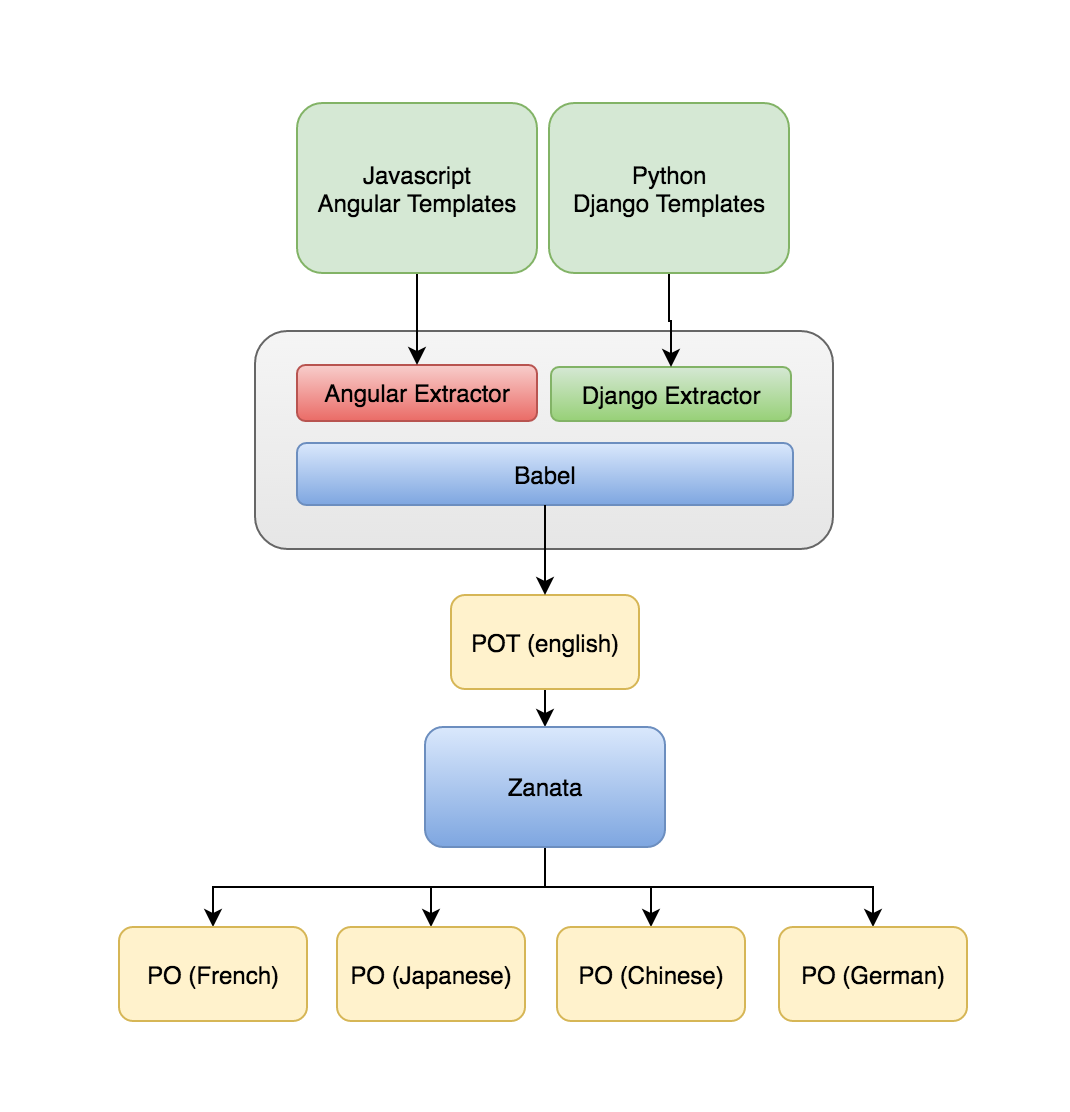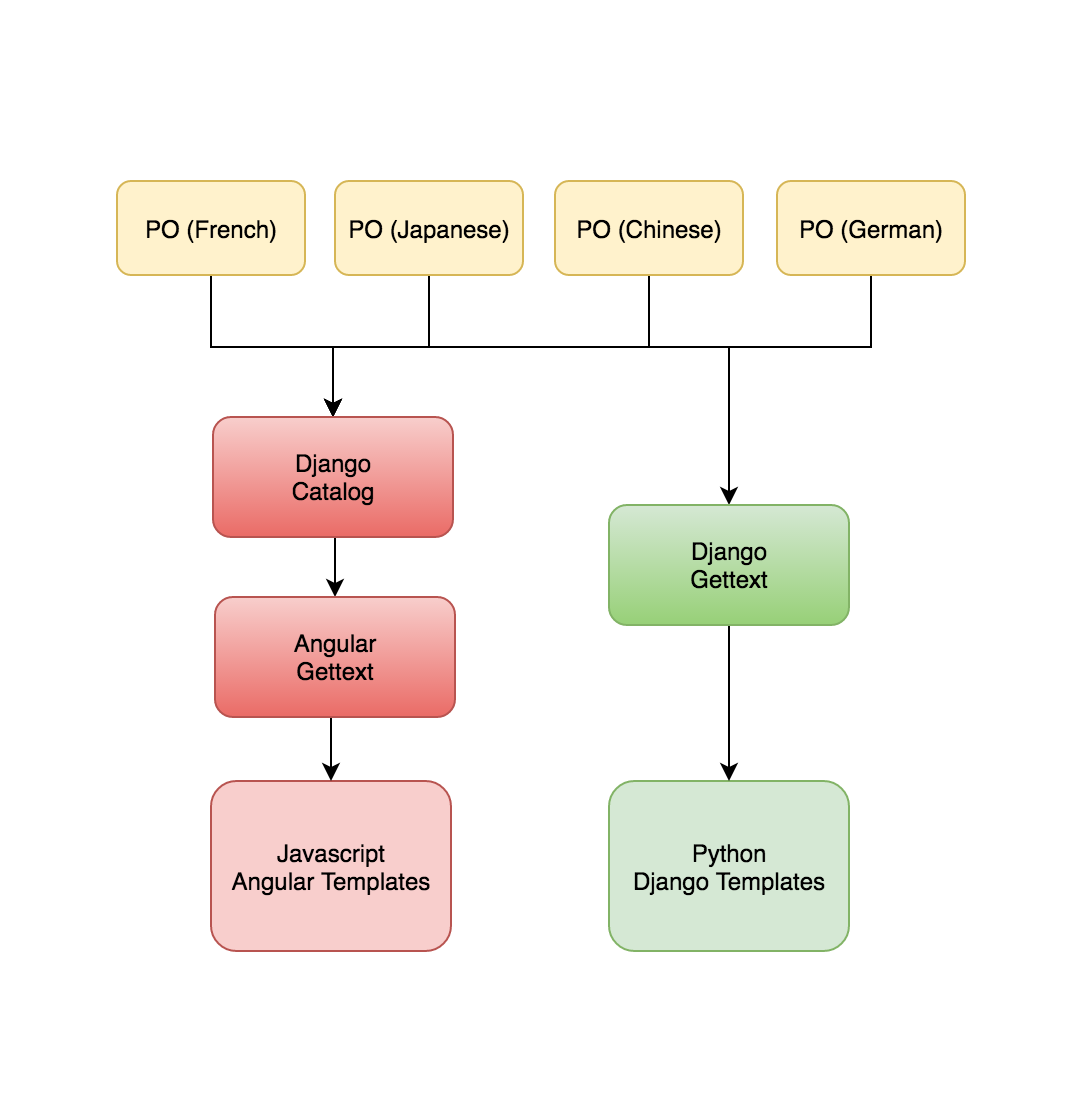[ English | English (United Kingdom) | português (Brasil) | français | 한국어 (대한민국) | русский | Indonesia | Deutsch | Esperanto | 中文 (简体, 中国) | नेपाली | español ]
Translation in Horizon¶
What is the point of translating my code?¶
You introduced an awesome piece of code and revel in your glorious accomplishment. Suddenly your world comes crashing down when a core hands you a -1 because your code is not translated. What gives?
If you are writing software for a global audience, you must ensure that it is translated so that other people around the world are able to use it. Adding translation to your code is not that hard and a requirement for horizon.
If you are interested in contributing translations, you may want to investigate Zanata and the upstream translations. You can visit the internationalization project IRC channel #openstack-i18n, if you need further assistance.
Overview and Architecture¶
You can skip this section if you are only interested in learning how to use translation. This section explains the two main components to translation: message extraction and message substitution. We will briefly go over what each one does for translation as a whole.
Message Extraction¶

Message extraction is the process of collecting translatable strings from the code. The diagram above shows the flow of how messages are extracted and then translated. Lets break this up into steps we can follow:
The first step is to mark untranslated strings so that the extractor is able to locate them. Refer to the guide below on how to use translation and what these markers look like.
Once marked, we can then run
tox -e manage -- extract_messages, which searches the codebase for these markers and extracts them into a Portable Object Template (POT) file. In horizon, we extract from both thehorizonfolder and theopenstack_dashboardfolder. We use the AngularJS extractor for JavaScript and HTML files and the Django extractor for Python and Django templates; both extractors are Babel plugins.To update the .po files, you can run
tox -e manage -- update_catalogto update the .po file for every language, or you can specify a specific language to update like this:tox -e manage -- update_catalog de. This is useful if you want to add a few extra translatabale strings for a downstream customisation.
Note
When pushing code upstream, the only requirement is to mark the strings correctly. All creation of POT and PO files is handled by a daily upstream job. Further information can be found in the translation infrastructure documentation.
Message Substitution¶

Message substitution is not the reverse process of message extraction. The process is entirely different. Lets walk through this process.
Remember those markers we talked about earlier? Most of them are functions like gettext or one of its variants. This allows the function to serve a dual purpose - acting as a marker and also as a replacer.
In order for translation to work properly, we need to know the user’s locale. In horizon, the user can specify the locale using the Settings panel. Once we know the locale, we know which Portable Object (PO) file to use. The PO file is the file we received from translators in the message extraction process. The gettext functions that we wrapped our code around are then able to replace the untranslated strings with the translated one by using the untranslated string as the message id.
For client-side translation, Django embeds a corresponding Django message catalog. Javascript code on the client can use this catalog to do string replacement similar to how server-side translation works.
If you are setting up a project and need to know how to make it translatable, please refer to this guide.
Making strings translatable¶
To make your strings translatable, you need to mark it so that horizon can locate and extract it into a POT file. When a user from another locale visits your page, your string is replaced with the correct translated version.
In Django¶
To translate a string, simply wrap one of the gettext variants around the string. The examples below show you how to do translation for various scenarios, such as interpolation, contextual markers and translation comments.
from django.utils.translation import gettext as _
from django.utils.translation import ngettext
from django.utils.translation import pgettext
class IndexView(request):
# Single example
_("Images")
# Plural example
ngettext(
"there is %(count)d object",
"there are %(count)d objects",
count) % { "count": count }
# Interpolated example
mood = "wonderful"
output = _("Today is %(mood)s.") % mood
# Contextual markers
pgettext("the month name", "May")
# Translators: This message appears as a comment for translators!
gettext("Welcome translators.")
Note
In the example above, we imported gettext as _. This is a common
alias for gettext or any of its variants.
In Django templates¶
To use translation in your template, make sure you load the i18n module. To
translate a line of text, use the trans template tag. If you need to
translate a block of text, use the blocktrans template tag.
Sometimes, it is helpful to provide some context via the comment template
tag. There a number of other tags and filters at your disposal should you need
to use them. For more information, see the
Django docs
{% extends 'base.html' %}
{% load i18n %}
{% block title %}
{% trans "Images" %}
{% endblock %}
{% block main %}
{% comment %}Translators: Images is an OpenStack resource{% endcomment %}
{% blocktrans with amount=images.length %}
There are {{ amount }} images available for display.
{% endblocktrans %}
{% endblock %}
In JavaScript¶
The Django message catalog is injected into the front-end. The gettext function is available as a global function so you can just use it directly. If you are writing AngularJS code, we prefer that you use the gettext service, which is essentially a wrapper around the gettext function.
Angular
.module(myModule)
.controller(myCtrl);
myCtrl.$inject = [
"horizon.framework.util.i18n.gettext"
];
function myCtrl(gettext) {
var translated = gettext("Images");
}
Warning
For localization in AngularJS files, use the AngularJS service
horizon.framework.util.i18n.gettext. Ensure that the injected dependency
is named gettext or nggettext. If you do not do this, message
extraction will not work properly!
In AngularJS templates¶
To use translation in your AngularJS template, use the translate tag or the translate filter. Note that we are using angular-gettext for message substitution but not for message extraction.
<translate>Directive example</translate>
<div translate>Attribute example</div>
<div translate>Interpolated {{example}}</div>
<span>{$ 'Filter example'| translate $}</span>
<span translate>
This <em>is</em> a <strong>bad</strong> example
because it contains HTML and makes it harder to translate.
However, it will still translate.
</span>
Note
The annotations in the example above are guaranteed to work. However, not all of the angular-gettext annotations are supported because we wrote our own custom babel extractor. If you need support for the annotations, ask on IRC in the #openstack-horizon room or report a bug. Also note that you should avoid embedding HTML fragments in your texts because it makes it harder to translate. Use your best judgement if you absolutely need to include HTML.
Pseudo translation tool¶
The pseudo translation tool can be used to verify that code is ready to be translated. The pseudo tool replaces a language’s translation with a complete, fake translation. Then you can verify that your code properly displays fake translations to validate that your code is ready for translation.
Running the pseudo translation tool¶
Make sure your .pot files are up to date
$ tox -e manage -- extract_messages
Run the pseudo tool to create pseudo translations. This example replaces the German translation with a pseudo translation
$ tox -e manage -- update_catalog de --pseudo
Compile the catalog
$ tox -e manage -- compilemessages
Run your development server.
$ tox -e runserver
Log in and change to the language you pseudo translated.
It should look weird. More specifically, the translatable segments are going to start and end with a bracket and they are going to have some added characters. For example, “Log In” will become “[~Log In~您好яшçあ]” This is useful because you can inspect for the following, and consider if your code is working like it should:
If you see a string in English it’s not translatable. Should it be?
If you see brackets next to each other that might be concatenation. Concatenation can make quality translations difficult or impossible. See Use string formatting variables, never perform string concatenation for additional information.
If there is unexpected wrapping/truncation there might not be enough space for translations.
If you see a string in the proper translated language, it comes from an external source. (That’s not bad, just sometimes useful to know)
If you get new crashes, there is probably a bug.
Don’t forget to remove any pseudo translated .pot or .po files.
Those should not be submitted for review.
